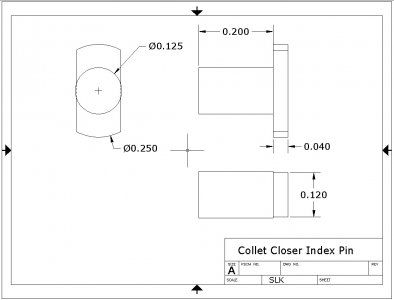Dan,
You are correct in referring to the part as an adaptor. It is a Morse 4-1/2 to 5C adaptor.
It's part of your collet closer, however a lever type collet closer has many parts. The adaptor is one of the components of the collet closer.
Regarding the pin, The pin should be installed into a through hole so, if part of it is still there, you should be able to see the butt end of the pin exposed. It will be a cylindrical pin. I would remove the remnant by pressing or carefully punching it out.
There are those that say you don't need the pin. I prefer to rely on the intent of the original designers and would replace a missing or damaged pin.
I think the pin is there only to index the collet and resist spinning while the draw tube is being threaded on and adjusted.
I would replace the pin with a nominal 1/8" (.1251-.1253) alloy steel pin. buy a pin at least 1/2" in length so you have something to hold onto.
Usually the pins come with domed or tapered ends. You want to grind off one end of the pin until it is square (not domed or tapered). Break the sharp edge with a diamond file or the like. Make certain there are no burrs. Any burrs will interfere with installation. Press the flattened end through the wall of the adaptor until it protrudes .045-.050" into the ID. Longer protrusion will hang on some collets. After the pin is installed to the proper depth, grind off any portion of the pin protruding from the OD of the adaptor. A small mark where a grinding wheel hits the OD of the adaptor is of no significance. Just be sure the pin doesn't protrude from the OD.
McMaster-Carr is the complete source for your plant with over 595,000 products. 98% of products ordered ship from stock and deliver same or next day.

www.mcmaster.com


